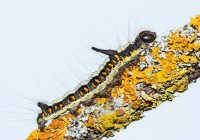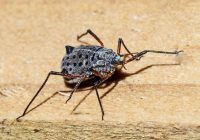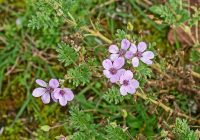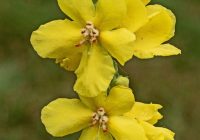Dr Phil Smith’s Wildlife Notes
October 2023
I remember plenty of wet Octobers and this was another. Rachael Park’s records show we had 22 rain-days and a total of 143 mm of rainfall, which was 64% more than normal in Formby. Accordingly, the dune water-table rose by about 17 cm. In line with the national picture, it was relatively mild. Although we had less sunshine than usual for October, there were enough sunny intervals to generate plenty of insect activity as the autumn progressed.
The south-facing fence-line on Wick’s Path, Formby Point, is one of my favourite places at this time of year. It didn’t let me down on 4th with a female Twin-spot Centurion, an autumnal member of the soldier-fly family. I have found it on the same bank for several successive years and nowhere else. A little further on, a superb Grey Dagger caterpillar had fallen off a tree onto the fence around Wick’s Lake. I rescued it and, after photographs, released it on a Hawthorn bush in my garden, where it started munching straight away. The fence usually produces plenty of the spectacular 6 mm-long Giant Willow Aphid but I could find only one. It has strange thorn-like tubercles on its back sometimes described as ‘shark’s-fins’, the function of which is unknown. Returning to Wick’s Path on 13th, I was amazed to find a male Speckled Bush-cricket sunning itself on Honeysuckle leaves. This is another southern insect that is charging north; but it’s wingless, so how does it travel? Also there was one of our less common hoverflies, the attractive Pale-knobbed Lucent.
Another well-trodden route to flowering Ivy at Ravenmeols produced a late Common Darter and a Dock Bug, the latter being a fairly recent colonist from the south. The path was lined with the lilac-coloured flowers of hybrid stork’s-bill, a cross between Common and Sticky Stork’s-bill. Although frequent in the Sefton duneland, this is a national rarity, largely confined to dunes in Merseyside and a few sites in Wales. TheIvy was good – eight pristine Red Admirals, one of my favourite butterflies, a Comma, eight species of hoverfly and a Noon Fly. A woodland glade nearby still had a few remaining flowers of Hungarian Mullein. I found it here in 2011 and it’s still the only site in the vice-county for this garden-escape. I counted 75 large non-flowering rosettes, so perhaps it’s starting to spread. Strolling back, with Nuthatch and Great Spotted Woodpecker calling from above, I decided to explore another glade. Suddenly, what I thought was a shieldbug landed on leaves above my head. Without looking, I reached up and grabbed it, only to find in my hand an enormous 2 cm-long Western Conifer Seed Bug. This was only the fourth individual I have seen of this North American introduction that became well-established in England and Wales from about 2007 and has now spread to parts of Scotland. It feeds on pines but does minimal damage. Remarkably, at the end of the month, Trevor Davenport told me of another found in his neighbour’s Freshfield garden.
Another great spot for south-facing Ivy is Hesketh Road at Marshside. I visited four times during the month and was delighted to find Ivy Bees each time, up to a maximum of five. As many as ten species of hoverfly included a single Pale-knobbed Lucent,as well as a Migrant Hawker swooping over my head, a Red Admiral and my latest ever Bronze Shieldbug. The real highlight, however, on 23rd was a large dark, heavily patterned fly. I sent a photo to fly expert Phil Brighton but he didn’t know it and forwarded it to Ian Andrews. With tension mounting, he decided that it was ‘probably’ a Golden-faced Polietes. This is a fairly recent addition to the British list, having been separated from a similar species in 2015. There are only about British 50 records, so far, and none previously for Sefton.
Also on Hesketh Road, the RSPB viewing platform, overlooking the rapidly flooding grazing marsh, gave views of up to 400 elegant Black-tailed Godwits, while snatches of song revealed a Cetti’s Warbler in the reeds. Several species of ducks returning for the winter included Wigeon, with their evocative whistles.
While at Marshside, I visited the Crossens Marsh watchpoint on the old Rainford’s compound. A large female Marsh Harrier was patrolling the endless saltmarsh, while a Merlin dashed past nearby. Inevitably, I had just missed the usual Hen Harrier.
The 12th season of ‘Buckthorn Bashes’ started on 5th with 12 volunteers meeting at Sands Lake, Ainsdale. We managed to fit in four events during the month, with up to 16 participants and, on the whole, were lucky with the weather. The last day of October found me helping Barry Smith of Natural England to mark rare hybrid willows at Cabin Hill NNR, so they can be avoided during essential scrub-clearance. It was hard going through dense reedbeds that have grown up on previously open duneland but we found all the target bushes, including one that produces catkins in the spring that are part male and part female.






